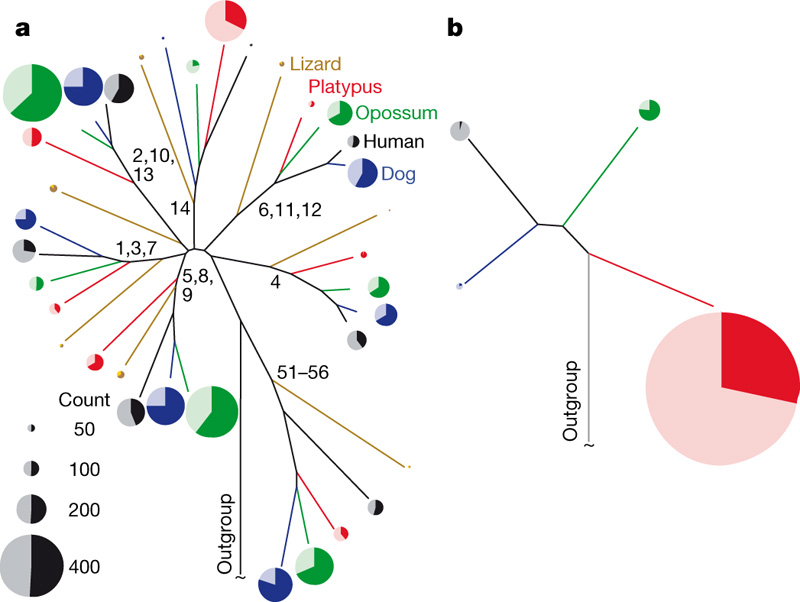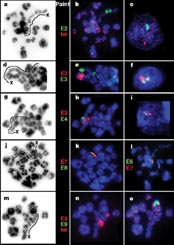There are many different areas of active platypus research. Listed here are a few different projects.
"Genome analysis of the platypus reveals unique signatures of evolution"
Summary by Holland M. Kaplan
In 1884, a Scottish embryologist came upon a female platypus who had just laid an egg. Upon this sight, he immediately walked to a telegraph station and transmitted the concise and imposing message, “Monotremes oviparous, ovum meroblastic.” This was astounding because it revealed that platypuses are not holoblastic like the other two groups of mammals evolved from therapsids. Since this telegram, the study of platypuses has amazed and befuddled the scientific community.
The Nature article “Genome analysis of the platypus reveals unique signatures of evolution” (Warren, Wesley C. et al) discusses different methods used by researchers to investigate the role played by the Australian platypus in evolution. The question posed is “What can the duck-billed platypus reveal about mammalian evolution and can any discovered information be used to facilitate the study of other mammals?” The rest of the article describes methods used by the researchers to complete the investigation, such as compiling the genomic sequence of the platypus and analyzing unusual characteristics of the platypus. It combines the results of this investigation in the conclusion.
The hypothesis posed in this article is “If various methods, including genomic sequencing and analysis, are applied to the study of the role played by the platypus in evolution, then the platypus’s unusual combination of mammalian and reptilian characteristics will allow advancements in other investigations of mammalian evolution.” Therefore, the independent variable in this study is the information gathered about the platypus including the platypus genome, chemoreception ability, lactation capacity, and venom capability. The dependent variables are the present position of the platypus in the evolutionary scheme and the common perception of evolution.
The results of the experiment showed that further study on the platypus could lead to discoveries which would facilitate the study of mammalian evolution. Specific data recorded included the fact that the platypus has 52 chromosomes, it contains many more natural killer receptor genes than humans, and its venom consists of at least 19 different substances. The researchers concluded that the sequencing of the platypus genome will allow comparison of its sequence characteristics with the genome of animals such as birds and other mammals in order to study the development of mammalian traits. The abundance of new findings presented in this article will lead to rapid advances in studies regarding mammalian evolution and biology.
The original hypothesis was supported based on the results of the experiment. The wealth of knowledge discovered about the platypus in addition to the sequencing of the platypus genome certainly promises further advancement in fields such as mammalian evolution and mammalian biology.
Citation:
Warren, Wesley C., LaDeana W. Hillier, Jennifer A. Marshall Graves, Ewan Birney, Chris P. Pontey, et al. "Genome analysis of the platypus reveals unique signatures of evolution." Nature 453 (2008): 175-83.
Summary by Holland M. Kaplan
In 1884, a Scottish embryologist came upon a female platypus who had just laid an egg. Upon this sight, he immediately walked to a telegraph station and transmitted the concise and imposing message, “Monotremes oviparous, ovum meroblastic.” This was astounding because it revealed that platypuses are not holoblastic like the other two groups of mammals evolved from therapsids. Since this telegram, the study of platypuses has amazed and befuddled the scientific community.
The Nature article “Genome analysis of the platypus reveals unique signatures of evolution” (Warren, Wesley C. et al) discusses different methods used by researchers to investigate the role played by the Australian platypus in evolution. The question posed is “What can the duck-billed platypus reveal about mammalian evolution and can any discovered information be used to facilitate the study of other mammals?” The rest of the article describes methods used by the researchers to complete the investigation, such as compiling the genomic sequence of the platypus and analyzing unusual characteristics of the platypus. It combines the results of this investigation in the conclusion.
The hypothesis posed in this article is “If various methods, including genomic sequencing and analysis, are applied to the study of the role played by the platypus in evolution, then the platypus’s unusual combination of mammalian and reptilian characteristics will allow advancements in other investigations of mammalian evolution.” Therefore, the independent variable in this study is the information gathered about the platypus including the platypus genome, chemoreception ability, lactation capacity, and venom capability. The dependent variables are the present position of the platypus in the evolutionary scheme and the common perception of evolution.
The results of the experiment showed that further study on the platypus could lead to discoveries which would facilitate the study of mammalian evolution. Specific data recorded included the fact that the platypus has 52 chromosomes, it contains many more natural killer receptor genes than humans, and its venom consists of at least 19 different substances. The researchers concluded that the sequencing of the platypus genome will allow comparison of its sequence characteristics with the genome of animals such as birds and other mammals in order to study the development of mammalian traits. The abundance of new findings presented in this article will lead to rapid advances in studies regarding mammalian evolution and biology.
The original hypothesis was supported based on the results of the experiment. The wealth of knowledge discovered about the platypus in addition to the sequencing of the platypus genome certainly promises further advancement in fields such as mammalian evolution and mammalian biology.
Citation:
Warren, Wesley C., LaDeana W. Hillier, Jennifer A. Marshall Graves, Ewan Birney, Chris P. Pontey, et al. "Genome analysis of the platypus reveals unique signatures of evolution." Nature 453 (2008): 175-83.
The text for the above article can be found here.
Below are two diagrams referred to in the research article.

This figure shows the emergence of traits along the mammalian lineage. Amniotes split into synapsids and sauropsids. Synapsids developed hair, homeothermy, and lactation (indicated by the red). Monotremes diverged from the therians about 166 million years ago.

This shows a schematic phylogenetic tree indicating the platypus chemosensory gene repertoire. The platypus genome has only a few genes of the olfactory receptor genes common among therians. The pie charts indicate the proportion of intact genes (heavily shaded) versus pseudogenes (lightly shaded). Pseudogenes are imperfect copies of functional genes.
"In the platypus a meiotic chain of ten sex chromosomes shares genes with the bird Z and mammal X chromosomes"
Summary by Holland M. Kaplan
Much regarding platypuses and monotremes in general remains unknown, especially in the field of genetics. In the article “In the platypus a meiotic chain of ten sex chromosomes shares genes with the bird Z and mammal X chromosomes,” researchers describe that a male platypus has five Y chromosomes and five X chromosomes and they analyze potential evolutionary links between the chromosomes systems among mammals and birds. Prior to this line of research, the accepted view was that bird and mammal chromosome systems evolved independently of each other.
The fact that a male platypus has five Y chromosomes and five X chromosomes has led to confusion regarding the mechanism of sex determination in platypuses. Researchers have not yet identified a SRY gene in platypuses, which is a sex-determining gene on the Y chromosomes present in mammals. In mammals, an XY chromosome combination codes for a male through the SRY gene. However, in birds there is a differing ZW chromosome combination for females which does not appear to involve the SRY gene. Although it has been proposed that the bird ZW system and the mammal XY systems share a common genomic system, this was invalidated upon the observation of the similar composition of chromosome 9 in humans and chromosome Z in chickens. The present consensus among researchers is that these two genomic systems evolved independently. However, the researchers in this article challenge this conclusion.
The researchers in “In the platypus a meiotic chain of ten sex chromosomes shares genes with the bird Z and mammal X chromosomes” use fluorescence in situ hybridization on metaphase chromosomes of male and female platypuses to identify platypus chromosomes from cultured fibroblasts. This experiment was performed in order to elucidate the long-standing pervasive confusion regarding platypus mitotic and meiotic chromosomes. The researchers concluded from this experiment that alternating segregation occurs in platypuses during telophase I of meiosis. They also demonstrated that the two ends of the platypus sex chromosome chain are similar to the mammal XY and bird ZW systems. This suggests that bird and mammal chromosome systems did not evolve independently. The researchers’ conclusion and the multiple sex chromosomes of platypuses are especially interesting to other researchers because the result of multiple sex chromosomes in most mammals leads to sterility of the male. Therefore, the fact that platypus chromosomes are able to effectively use alternating segregation of five X chromosomes and five Y chromosomes is important to any further study of comparative genomics and sex chromosome evolution.
Researchers are still attempting to answer questions such as where the SRY gene disappeared in the evolutionary scheme and if it is in fact absent in platypuses. Clarification regarding the evolution and genetic information of monotremes could lead to further discoveries in genetics.
Citation:
Grutzner, Frank, Willem Rens, Jennifer Graves, et al. “In the platypus a meiotic chain of ten sex chromosomes shares genes with the bird Z and mammal X chromosomes.” Nature 432 (2004): 913-17.
Here is the .pdf file of the above article:

|
nature03021.pdf Size : 0.298 Kb Type : pdf |
Below is a diagram referred to in the research article.

This image shows the order of chromosomes on the meiotic chain.